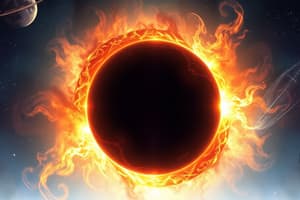Podcast
Questions and Answers
What is the primary source of energy for almost all organisms on Earth?
What is the primary source of energy for almost all organisms on Earth?
- Thermal energy from the Earth's core
- Solar energy from the Sun (correct)
- Chemicals in the Earth's crust
- Geothermal energy from volcanoes
What could be the source of thermal energy on some moons?
What could be the source of thermal energy on some moons?
- Heating of the satellite's interior (correct)
- Gravitational energy from the parent planet
- Solar radiation
- Chemical reactions in the moon's core
What do astronauts use to shield themselves from solar radiation and particles?
What do astronauts use to shield themselves from solar radiation and particles?
- The Earth's magnetic field
- Their spacecraft and spacesuits (correct)
- A protective shield around the spacecraft
- Space suits made of a special material
How do astronauts obtain oxygen for long trips?
How do astronauts obtain oxygen for long trips?
What is the International Space Station (ISS)?
What is the International Space Station (ISS)?
Who constructed the International Space Station (ISS)?
Who constructed the International Space Station (ISS)?
When was the first crew of the International Space Station (ISS) deployed?
When was the first crew of the International Space Station (ISS) deployed?
What is the main function of a spacecraft for astronauts?
What is the main function of a spacecraft for astronauts?
What is the significance of the International Space Station (ISS)?
What is the significance of the International Space Station (ISS)?
Flashcards are hidden until you start studying
Study Notes
Tides and Eclipses
- Spring tides occur at new and full moons, and have the highest high tides and lowest low tides.
- Neap tides occur at first- and third-quarter moons, and have the lowest high tides and highest low tides.
- Solar eclipses can only be seen from within the shadow of the Moon.
- Lunar eclipses can only occur during a full moon.
- Solar eclipses occur only during a new moon because the Moon, Earth, and Sun must be aligned.
The Solar System
- The outer layer of the solar system is the Oort cloud.
- Ices formed far from the Sun, where temperatures were extremely cold.
- Rocks formed closer to the Sun, where temperatures were hotter.
- Metals formed even closer to the Sun, where temperatures were extremely hot.
- Planets further from the Sun formed as ices.
- The Sun is the source of almost all energy on Earth.
Earth's Rotation and Revolution
- Earth rotates from west to east.
- Objects in the sky appear to move in the opposite direction, from east to west.
- The difference between a planet's rotation and its revolution is that rotation is the spinning of a planet on its axis, while revolution is the orbit of a planet around the Sun.
Climate and Weather
- Continental polar air masses are very cold and dry, and form over the interiors of Canada and Alaska.
- Continental tropical air masses are warm and dry, and form over the southwest United States and Mexico.
- Maritime polar air masses are mild and humid, and form over the North Pacific Ocean.
- Maritime polar air masses are cold and humid, and form over the North Atlantic Ocean.
- Deforestation can cause changes in climate.
- The city with the smallest change in average temperature between January and July is San Francisco.
- The factor that strongly influences the climate of San Francisco is the ocean west of the city.
Review Questions
- Organisms on Earth receive energy from the Sun and also from Earth itself.
- The longest a total solar eclipse can last is about 7 minutes.
- The atmosphere is 21 percent oxygen and 78 percent nitrogen.
- Water vapor makes up less than 1 percent of the total atmosphere.
- The heating of a satellite's interior may provide enough thermal energy to allow for liquid water on the moons.
- Astronauts rely on their spacecraft and spacesuits to shield them from dangerous solar radiation and solar particles.
- Oxygen is supplied for long trips by passing an electric current through water.
- The International Space Station (ISS) is a large, artificial satellite that orbits Earth and has been continuously occupied since the first crew arrived in 2000.
Studying That Suits You
Use AI to generate personalized quizzes and flashcards to suit your learning preferences.




